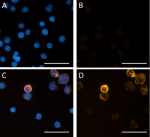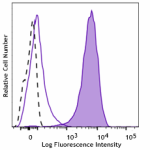- Clone
- A20007B (See other available formats)
- Regulatory Status
- RUO
- Other Names
- Lymphocyte cytosolic protein 2 (LCP2), SH2 domain-containing leukocyte protein of 76 kDa (SLP76), IMD81
- Isotype
- Mouse IgG1, κ

-

Jurkat cells left untreated (panels A and B) or treated with H2O2 (panels C and D) were fixed with 4% PFA Fixation Buffer (Cat. No. 420801) for 10 minutes and permeabilized with 100% ice-cold methanol for 10 minutes, and blocked with 5% FBS for 1 hour at room temperature. Cells were then stained with 2.5 µg/mL of purified anti-SLP76 Phospho (Tyr128) (clone A20007B), followed by incubation with Alexa Fluor® 594 goat anti-mouse IgG (Cat. No. 405326) for 1 hour at room temperature. Nuclei were counterstained with DAPI (panels A and C)(Cat. No. 422801). The images were captured in a Revvity Operetta CLS™ High Content Analysis System with a 40X objective. Scale bar: 25 µm -

Jurkat cells untreated (low expression control, open histogram), or treated with H2O2 for 5 minutes (positive control, filled histogram) were fixed and permeabilized using the Cyto-Fast™ Fix/Perm Buffer Set (Cat. No. 426803) and intracellularly stained with purified anti-SLP76 Phospho (Tyr128) (clone A20007B) or mouse IgG1, κ isotype control (open histogram, dashed line) (representative histogram for untreated or treated cells) (Cat. No. 401401) followed by PE goat anti-mouse IgG (Cat. No. 405307).
| Cat # | Size | Price | Quantity Check Availability | ||
|---|---|---|---|---|---|
| 618851 | 25 µg | $193.00 | |||
| 618852 | 100 µg | $385.00 | |||
SLP76 is a cytosolic adaptor protein that functions as a substrate in the T cell receptor (TCR) activation pathway. Upon TCR engagement, SLP76 is phosphorylated on multiple residues by ZAP70, resulting in the protein being translocated to the plasma membrane and facilitating the assembly of a multi-subunit complex comprised of Vav1, Nck, ITK, and PLCγ1 that activates multiple signaling pathways. Mutation and inactivation of the phosphorylation sites results in abrogation of SLP76 activity. Tyr128 is one of three residues on the N-terminus of SLP76 which becomes phosphorylated upon TCR ligation, which initiates immune cell synapse formation. SLP76 also plays an essential role in normal T cell development, and mast cell and platelet function.
Product Details
- Verified Reactivity
- Human
- Antibody Type
- Monoclonal
- Host Species
- Mouse
- Immunogen
- Synthetic human SLP76 peptide phosphorylated at Tyr128
- Formulation
- Phosphate-buffered solution, pH 7.2, containing 0.09% sodium azide
- Preparation
- The antibody was purified by affinity chromatography.
- Concentration
- 0.5 mg/mL
- Storage & Handling
- The antibody solution should be stored undiluted between 2°C and 8°C.
- Application
-
ICC - Quality tested
ICFC - Verified - Recommended Usage
-
Each lot of this antibody is quality control tested by immunocytochemistry. For immunocytochemistry, a concentration range of 2.5 - 5.0 μg/mL is recommended. For flow cytometric staining, the suggested use of this reagent is ≤ 0.125 µg per million cells in 100 µL volume. It is recommended that the reagent be titrated for optimal performance for each application.
- Application Notes
-
Clone is not suitable for Western Blot application. Although the antibody does detect phospho-SLP76, there is a prominent non-specific band around 35 kDa.
For immunocytochemistry, successful staining was accomplished using fixation with 4% PFA for 10 minutes followed by permeabilization with either 100% ice-cold methanol or 0.5% Triton-X for 10 minutes, or with fixation/permeabilization with 100% ice-cold methanol for 10 minutes.
For flow cytometry, we recommend treatment with Cyto-Fast™ Fix/Perm Buffer Set (Cat. No. 426803). - RRID
-
AB_3083403 (BioLegend Cat. No. 618851)
AB_3083403 (BioLegend Cat. No. 618852)
Antigen Details
- Structure
- SLP76 is a 533 amino acid protein with a predicted molecular weight of ~60 kD.
- Distribution
-
Hematopoietic cells/cytosol
- Function
- Adaptor protein/TCR Signaling
- Interaction
- ZAP70, ITK, LAT, GRB2, PLCγ1, NCK, VAV, ITK, LCK, 14-3-3ε
- Cell Type
- B cells, Monocytes, NK cells, T cells
- Biology Area
- Cell Biology, Immunology, Signal Transduction
- Molecular Family
- Phospho-Proteins, Protein Kinases/Phosphatase
- Antigen References
-
- Sauer K, et al. 2001. J Biol Chem. 276:45207-16.
- Koretzky GA, et al. 2006. Nat Rev Immunol. 6:67-78.
- Di Bartolo V, et al. 2007. J Exp Med. 204:681-91.
- Lasserre, et al. 2011. J Cell Biol. 195:839-53.
- Wardenberg, et al. 1996. J Biol Chem. 271:33.
- Gene ID
- 3937 View all products for this Gene ID
- UniProt
- View information about SLP76 Phospho (Tyr128) on UniProt.org
Other Formats
View All SLP76 Phospho Tyr128 Reagents Request Custom Conjugation| Description | Clone | Applications |
|---|---|---|
| Purified anti-SLP76 Phospho (Tyr128) | A20007B | ICC,ICFC |
Compare Data Across All Formats
This data display is provided for general comparisons between formats.
Your actual data may vary due to variations in samples, target cells, instruments and their settings, staining conditions, and other factors.
If you need assistance with selecting the best format contact our expert technical support team.
-
Purified anti-SLP76 Phospho (Tyr128)

Jurkat cells left untreated (panels A and B) or treated with... 
Jurkat cells untreated (low expression control, open histogr...
